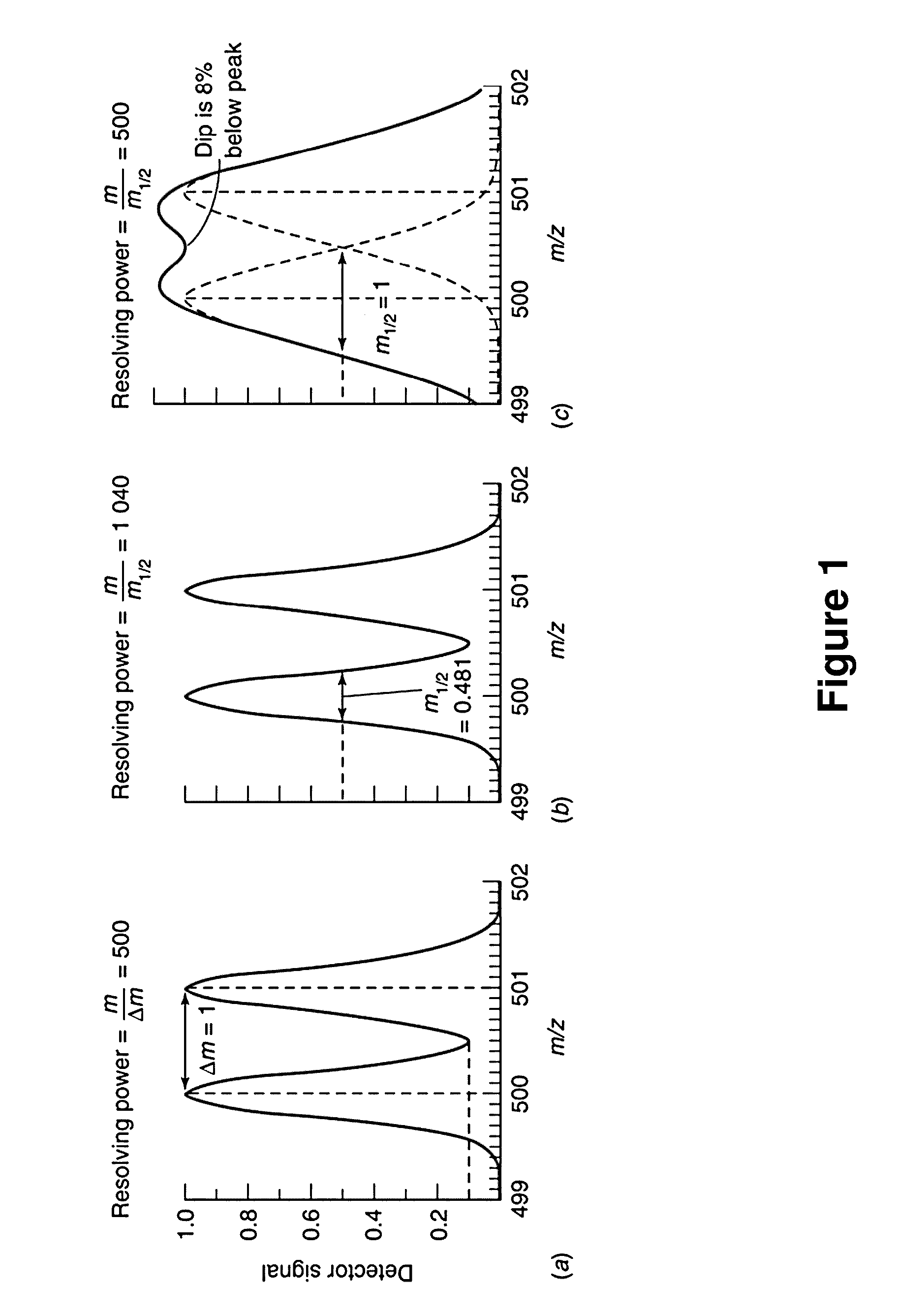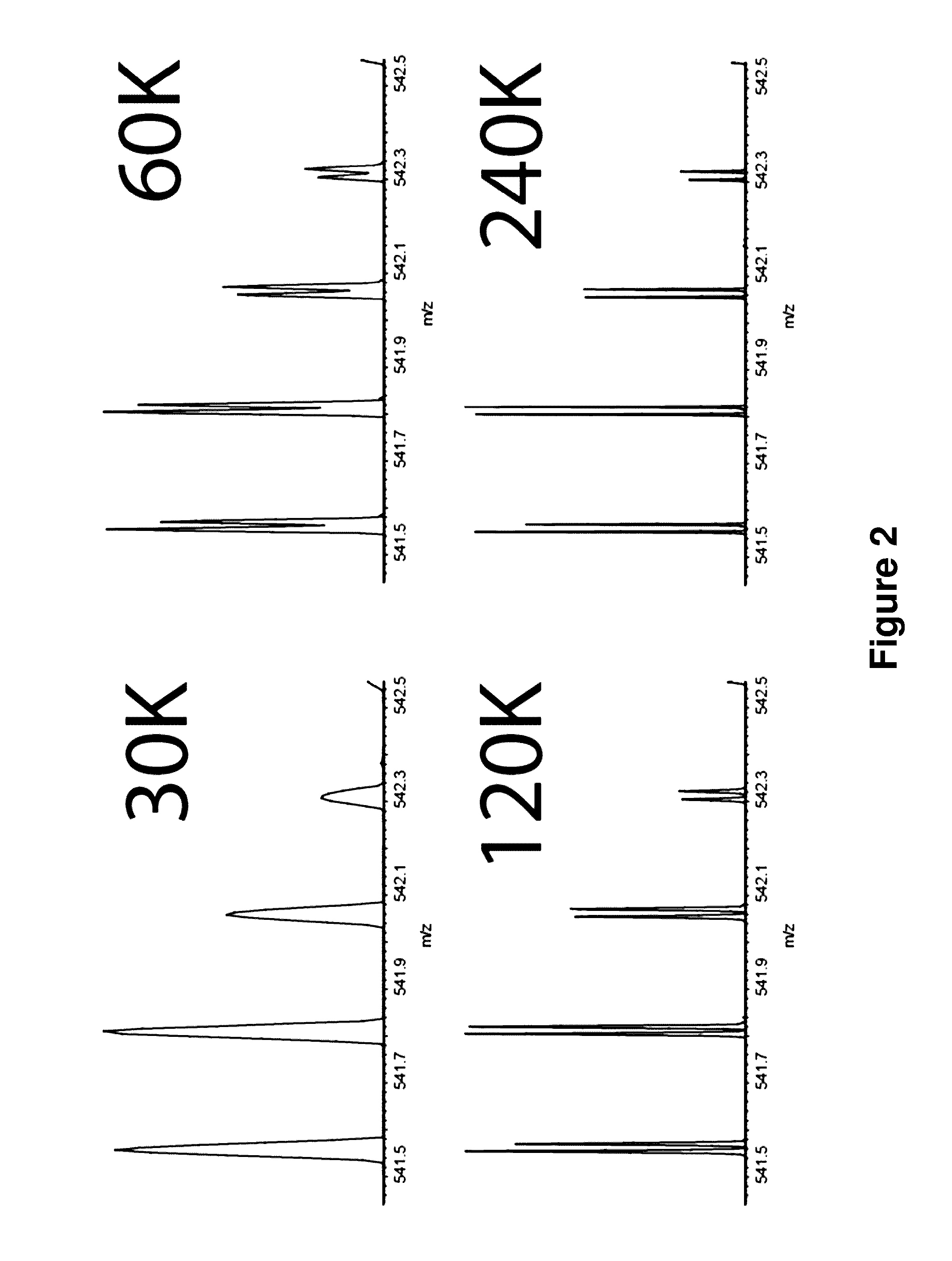Neutron Encoded Mass Tags for Analyte Quantification
a technology of neutron encoded mass and analyte, which is applied in the direction of instrumentation, assay labels, material analysis, etc., can solve the problems of limiting the quantitative capacity of silac to triplex, using quantitative analysis for proteomics applications, and demonstrating that methods are susceptible to certain limitations, etc., to achieve accurate resolution. , the effect of high degree of multiplexing
- Summary
- Abstract
- Description
- Claims
- Application Information
AI Technical Summary
Benefits of technology
Problems solved by technology
Method used
Image
Examples
example 1
Background of SILAC and Isobaric Tagging Methods and Overview of Neutron Encoded Mass Tagging
[0110]Protein identification technologies have rapidly matured such that constructing catalogs of the thousands of proteins present in a cell using mass spectrometry is now relatively straightforward. Knowing how the abundance of these molecules change under various circumstances, however, is not straightforward. Stable isotope incorporation is a central component of many MS-based protein quantification strategies. Presently, there are two main approaches to accomplish this. The first is to metabolically introduce heavy stable isotopes (i.e., 13C, 18O, 15N, 2H) into proteins during cell growth. In SILAC, amino acids that incorporate stable isotopes, which are typically 4 or 8 Da heavier than the normal amino acids, are included in the cell culture media so that all synthesized proteins incorporate the heavy amino acids. Combination of cells grown on heavy and light media produce identical pr...
example 2
Neutron-Encoded Signatures for Multiplexed Protein Quantification
[0157]Applying a neutron-encoded tagging system to protein quantification involves exploiting the subtle mass differences that are induced by the varying energies of neutron binding in C, N, O, S, CI, Br, Si and H atoms. For example, a difference in mass of 6 mDa can be induced by swapping a 14N for a 15N atom while concomitantly switching a 13C with a 12C atom in the analyte molecule. Doing this process in various combinations, within the context of an analyte molecule, generates dozens of chemically identical isotopologues that when analyzed under normal MS analysis conditions (mass resolution 100,000 resolution), however, reveals distinct m / z peaks whose abundances can be extracted and used to determine analyte quantity across the sundry conditions. This technology will permit very high levels of multiplexing (such as 45-plex systems, ultraplexing) while avoiding the pitfalls of both SILAC and isobaric tagging. Appl...
example 3
Neutron Encoded Amino Acids
[0162]The above data demonstrates the feasibility of the NeuCode tagging strategy and doubles the plexing capacity provided by SILAC. For increased plexing, custom isotopologues of SILAC amino acids are synthesized. To determine the most expedient strategy, the mass range and number of NeuCode isotopologues for each of the six amino acids used for SILAC (Ser, Leu, Tyr, Lys, Met, and Arg) were calculated. These six amino acids alone can be manipulated to produce 3,004 isotopologues (FIG. 13)! On average, these isotopologues are spaced 1.07 mDa apart over ranges of 26-63 mDa. This means that the plexing capacity can be maximized by precisely matching isotopologue offset mass spacing to the currently achievable mass resolution. Arg offers the widest offset mass range (62.8 mDa) and, thus, the potential for the highest level of multiplexing.
[0163]Traditional SILAC experiments, however, utilize either Lys, alone, or in combination with Arg. Since custom amino a...
PUM
 Login to View More
Login to View More Abstract
Description
Claims
Application Information
 Login to View More
Login to View More - R&D
- Intellectual Property
- Life Sciences
- Materials
- Tech Scout
- Unparalleled Data Quality
- Higher Quality Content
- 60% Fewer Hallucinations
Browse by: Latest US Patents, China's latest patents, Technical Efficacy Thesaurus, Application Domain, Technology Topic, Popular Technical Reports.
© 2025 PatSnap. All rights reserved.Legal|Privacy policy|Modern Slavery Act Transparency Statement|Sitemap|About US| Contact US: help@patsnap.com



